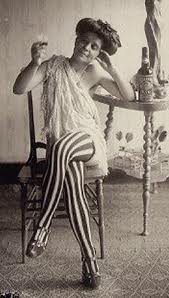On a Skyline cruise of Manhattan’s midtown harbor yesterday (which, by the way, I highly recommend), we were lucky enough to have as our guide a smart and sassy Irish-New Yorker, Danny, who delivered some fascinating nuggets of NYC information that probably aren’t included on the Skyline script or in any of the history or guide books. Among these gems was a little-known explanation of how the word hooker (as in prostitute) found its way into our language.
First, let’s get hooker‘s other meanings out of the way. The OED gives the following other definitions:
1. A small Dutch or Irish fishing vessel.
2. derog. any ship. [Dutch hoeker from hoek HOOK] [I’m loving the nautical theme here]
3. Rugby: the player in the middle of the front row of the scrum who tries to hook the ball
4. A person or thing that hooks
It’s also defined elsewhere as a glass or drink of undiluted brandy, whiskey, or other liquor, as well as a concealed problem, flaw, drawback, or a catch.
Now, here’s what Danny the tour guide told us.
It’s generally understood that hooker (as in lady of the night) dates back to the American Civil War, and the time of a charismatic, hard-drinking major general called “Fighting Joe” Hooker who led and fought some of the key battles of the time in Virginia and Pennsylvania, being defeated ultimately and famously at the Battle of Chancellorsville in 1863. As legend has it, this ladies’ man’s legacy wasn’t just a military one: his reputation as a womanizer led his band of female camp followers to be known as “Hooker’s Women” – or “Hookers” for short.
However, there are several references to the word hooker that pre-date the Civil War and therefore cast doubt on this particular etymology, colorful though it sounds (and real as Major General Hooker is known to have been). Danny the tour guide took us back to a slightly earlier time and place – to 1830s New York, and specifically an area on Manhattan’s Lower East Side known as “Corlear’s Hook”. This point at the bottom end of the East River – which was known briefly as “Crown Point” under British occupation during the revolution (shown in the map below), where the river literally ‘hooks’ around the island of Manhattan – was an important landmark for navigators for 300 years, and “as early as 1816 was notorious for streetwalkers, ‘a resort for the lewd and abandoned of both sexes’, and in 1821 its ‘streets abounding every night with preconcerted groups of thieves and prostitutes’ were noted by the ‘Christian Herald'” (from Wikipedia). And hence, as Danny explained it, during the early part of the 19th century these streetwalkers came to be known as hookers.
One of the word’s earliest official debuts in the lexicon was its appearance in the second edition of John Bartlett’s Dictionary of Americanisms of 1859.



Chambers Slang Dictionary acknowledges both the geographical and eponymous possibilities, but concludes ‘the etymology is probably the Standard English [from the verb ‘hook’, meaning ‘to catch, lure, entice’] but with strong reinforcement from the geographical reference’. It also suggests a link to the nautical term ‘hooker’, ‘a sailor’s affectionate term for a vessel and thus synonymous with various terms equating a whore with a ship’.